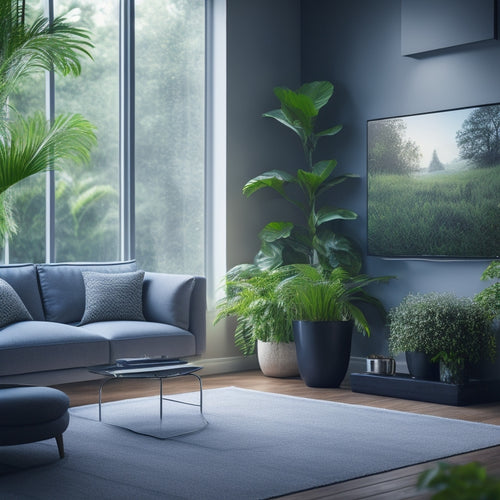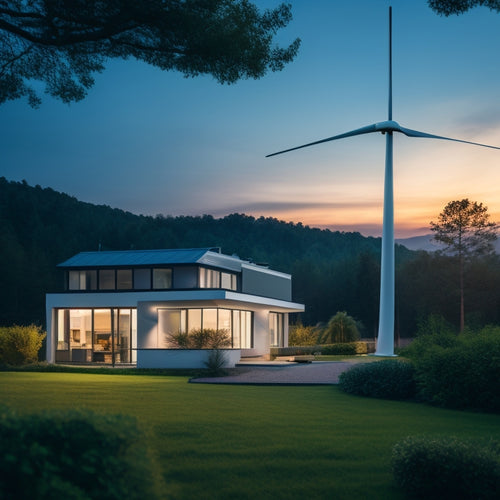
Top 10 Solar-Reflective Roofing Materials: Efficiency Showdown
Share
You're about to uncover the top 10 solar-reflective roofing materials that are transforming the game in energy efficiency and eco-friendliness. From Titanium Dioxide Coatings to Ceramic-Based Cool Roofs, Polyvinylidene Fluoride Films, and Acrylic Polymer Roof Coatings, each material brings its unique strengths to the table. Silicone-Based Reflective Finishes, Aluminum-Foil Backed Sheets, and PVC Roofing Membranes with TiO2 are also in the mix. Cool Asphalt Shingles with Granules and Fiber-Reinforced Polymer Panels round out the list. As you investigate these state-of-the-art options, you'll reveal the best fit for your energy-saving and sustainability goals, and get ready to take your building's performance to the next level.
Key Takeaways
- Titanium dioxide coatings reduce heat gain and energy consumption, with 20-60% TiO2 by weight, serving as the primary pigment for solar-reflective properties.
- Cool roof technologies, such as ceramic-based and acrylic polymer roof coatings, achieve high solar reflectance, mitigating urban heat islands and reducing energy consumption.
- Silicone-based reflective finishes offer 85-90% heat reflectivity, redirecting solar energy and enhancing energy efficiency, with a lifespan of up to 20 years.
- Advanced materials like polyvinylidene fluoride films and fiber-reinforced polymer panels provide high solar reflectance, contributing to reduced urban heat island effects and sustainable building design.
- Innovative technologies, such as TiO2 particle dispersion in PVC roofing membranes, increase albedo, reduce surface temperature, and enhance UV resistance and durability.
Titanium Dioxide Coatings
Most commercial titanium dioxide coatings contain between 20% to 60% TiO2 by weight, which is the primary pigment responsible for their solar-reflective properties.
You'll find these coatings used in various titanium dioxide applications, including roofing materials, paints, and coatings. The high TiO2 content enables these coatings to reflect a significant amount of solar radiation, reducing heat gain and energy consumption.
Additionally, integrating solar-powered EV charging solutions can further enhance energy efficiency and reduce reliance on traditional power sources.
However, it's crucial to reflect on the environmental impact of titanium dioxide production, as it requires significant energy and resources.
As you investigate titanium dioxide coatings for your roofing needs, weigh the benefits of energy efficiency against the potential ecological costs.
Ceramic-Based Cool Roofs
Ceramic-based cool roofs take the reins in solar-reflective roofing materials, offering an innovative solution to mitigate urban heat islands. As you consider this option, you'll want to know that ceramic properties make them highly reflective, with some products boasting up to 80% solar reflectance. This means they can greatly reduce heat gain and energy consumption.
By achieving energy independence, ceramic-based cool roofs can mitigate volatility in fuel prices and enhance operational efficiency through solar energy utilization. Regular maintenance, including cleaning and inspecting connections, is vital for optimizing performance and guaranteeing longevity, as regular cleaning of solar panels can prevent up to 20% efficiency loss.
When it comes to installation, you'll want to keep the following in mind:
- Ceramic tiles can be installed using traditional roofing techniques, such as mortar and grout.
- They can also be applied as a coating to existing roofs.
- Proper surface preparation is essential to guarantee a strong bond between the ceramic material and the substrate.
- Installation techniques may vary depending on the specific product and roof type.
- Regular maintenance is necessary to maintain the roof's reflective properties and extend its lifespan.
Polyvinylidene Fluoride Films
Investigate Polyvinylidene Fluoride (PVDF) films, a versatile and high-performance solar-reflective roofing material that offers excellent durability and weather resistance.
You'll find PVDF films are commonly used in roofing applications due to their high solar reflectance, resulting in significant energy savings. They're also resistant to UV degradation, ensuring their reflective properties remain consistent over time.
In addition, the growing network of green energy charging stations highlights the importance of sustainable energy solutions, which is where PVDF films come into play. By integrating PVDF films into building design, designers can reduce roof temperatures, decreasing the load on the building's cooling system.
In addition, polyvinylidene fluoride applications extend beyond roofing, including uses in design, construction, and even automotive industries.
Acrylic Polymer Roof Coatings
As you investigate solar-reflective roofing materials, acrylic polymer roof coatings emerge as a viable alternative, offering a unique set of benefits that can be customized to specific project requirements.
These coatings provide a cost-effective solution for reducing energy consumption and environmental impact. In addition, integrating solar energy for EV charging stations solar energy reduces grid reliance and carbon footprint, making them an attractive option for eco-friendly projects.
Moreover, regular maintenance, including cleaning, is essential for peak energy efficiency. They can be applied using various application techniques, including rolling, brushing, and spraying, making them versatile and easy to install.
Acrylic polymer roof coatings offer excellent durability and resistance to UV rays, cracking, and fading. They provide significant environmental benefits, including reduced heat island effect and lower energy consumption.
These coatings are available in a range of colors and finishes, allowing for aesthetic customization. They can be used on various roofing substrates, including metal, concrete, and asphalt.
Silicone-Based Reflective Finishes
When you're considering silicone-based reflective finishes for your solar-reflective roofing material, you'll want to pay close attention to coating durability.
A finish that can withstand harsh weather conditions and maintain its reflective properties over time is vital for peak energy efficiency.
As the trucking industry adopts sustainable practices, such as integrating solar panels, it's important to prioritize energy efficiency in building design as well.
Coating Durability Matters
You'll find that silicone-based reflective finishes are a popular choice for solar-reflective roofing materials due to their excellent durability and resistance to weathering.
When it comes to coating durability, you want a finish that can withstand harsh environmental conditions without compromising its performance.
Here are some key benefits of silicone-based reflective finishes:
-
Longer coating lifespan: Silicone-based finishes can last up to 20 years or more, reducing the need for frequent reapplications and minimizing environmental impact.
-
Chemical resistance: They resist degradation from chemicals and pollutants, ensuring consistent performance over time.
-
UV stability: Silicone-based finishes maintain their reflective properties even when exposed to intense UV radiation.
-
Water resistance: They can withstand heavy rainfall and moisture without compromising their reflective capabilities.
-
Easy maintenance: Silicone-based finishes are simple to clean and maintain, reducing the need for extensive upkeep.
Heat Reflectivity Boost
Solar-reflective roofing materials rely on their ability to reflect heat, and silicone-based reflective finishes deliver a significant heat reflectivity enhancement. You'll benefit from improved solar energy efficiency, reduced energy consumption, and a longer roof lifespan.
| Finish Type | Heat Reflectivity (%) |
|---|---|
| Silicone-based | 85-90 |
| Acrylic-based | 70-75 |
| Polyurethane-based | 65-70 |
These finishes work by creating a reflective surface that redirects solar energy away from your building. This reduces the amount of heat absorbed, keeping your roof cooler and more energy-efficient. By choosing a silicone-based reflective finish, you'll maximize your roof's heat reflectivity, ensuring a cooler, more comfortable space while minimizing your environmental impact.
White EPDM Rubber Membranes
You'll find that white EPDM rubber membranes offer significant thermal performance benefits, reducing the urban heat island effect and energy consumption.
By reflecting solar radiation, these membranes can lower roof temperatures, resulting in improved indoor comfort and reduced cooling costs.
Additionally, their durability and ease of maintenance make them a practical choice for building owners seeking a reliable, long-term roofing solution.
Thermal Performance Benefits
Among the most significant advantages of white EPDM rubber membranes lies their exceptional thermal performance benefits.
You'll experience a substantial reduction in heat gain during summer and heat loss during winter, resulting in significant energy savings. This, in turn, minimizes your environmental impact by reducing the need for air conditioning and heating.
Some key benefits of white EPDM rubber membranes' thermal performance include:
- Reduced energy consumption for cooling and heating
- Lower greenhouse gas emissions from HVAC systems
- Increased comfort level in buildings due to consistent indoor temperatures
- Extended lifespan of HVAC equipment due to reduced wear and tear
- Compliance with energy efficiency regulations and building codes
Durability and Maintenance
Since their introduction, white EPDM rubber membranes have consistently demonstrated exceptional durability and resistance to various environmental factors, making them a reliable choice for building owners and designers.
You can expect them to withstand harsh weather conditions, including UV radiation, high temperatures, and extreme weather events, without compromising their performance.
This superior weather resistance translates to minimal maintenance costs over the lifespan of the material. You'll spend less time and money on repairs and replacements, freeing up resources for more important things.
With white EPDM rubber membranes, you can enjoy long-term peace of mind, knowing your roof is protected and your building is secure.
Aluminum-Foil Backed Sheets
Aluminum-foil backed sheets are a type of solar-reflective roofing material that has gained popularity in recent years due to their high reflectivity and durability.
You'll appreciate their ability to reduce heat gain and energy consumption, giving you more freedom to focus on what matters.
When considering aluminum-foil backed sheets, keep in mind the following benefits:
- Easy installation techniques, often using a simple peel-and-stick method
- High reflectivity, with some products boasting up to 80% solar reflectance
- Durability, with some products lasting up to 20 years or more
- Low environmental impact, as they're often made from recyclable materials
- Cost-effective, with prices competitive with other solar-reflective materials
PVC Roofing Membranes With Tio2
You'll find that PVC roofing membranes with TiO2 particles offer improved solar reflectivity, which is largely dependent on the dispersion of these particles throughout the membrane.
When TiO2 particles are evenly dispersed, they help to scatter and reflect solar radiation, resulting in a significant enhancement to energy efficiency.
Tio2 Particle Dispersion
By incorporating titanium dioxide (TiO2) particles into PVC roofing membranes, manufacturers can create a more sustainable and energy-efficient roofing solution.
You'll benefit from improved solar reflectance, which reduces the urban heat island effect and minimizes the environmental impact of your building.
When dispersed evenly, TiO2 particles:
- Increase the membrane's albedo (solar reflectance) by up to 20%
- Reduce the surface temperature by as much as 20°C
- Enhance the membrane's UV resistance and durability
- Allow for more efficient cooling systems and reduced energy costs
- Provide a cost-effective alternative to traditional cool roofing materials in TiO2 applications
With TiO2 particle dispersion, you can enjoy a cooler, more sustainable roofing solution that benefits both your wallet and the environment.
Energy Efficiency Boost
The incorporation of TiO2 particles into PVC roofing membranes greatly enhances energy efficiency, leading to reduced energy consumption and lower energy costs.
You'll benefit from a significant decrease in the amount of heat absorbed by your building, which in turn reduces the load on your cooling system. This means you'll enjoy substantial cost savings on your energy bills.
By reflecting a higher percentage of solar radiation, these membranes minimize the urban heat island effect, creating a more comfortable and sustainable urban environment.
With TiO2-infused PVC roofing membranes, you can expect a noticeable reduction in energy consumption, leading to a more energy-efficient and cost-effective building operation.
Cool Asphalt Shingles With Granules
Installed on millions of homes, cool asphalt shingles with granules have become a staple in the roofing industry, offering a cost-effective solution for reducing urban heat island effects.
As you consider this option, you'll appreciate its energy savings and aesthetic appeal.
Here's what you can expect:
-
Reflectivity: Granules reflect solar radiation, reducing heat absorption and keeping your home cooler.
-
Durability: Asphalt shingles with granules last longer than traditional asphalt shingles.
-
Versatility: They come in various colors and styles to suit your home's design.
-
Cost-effectiveness: Granule-coated asphalt shingles are an affordable option for solar-reflective roofing.
-
Easy installation: They can be installed using traditional roofing methods, making the process seamless.
Fiber-Reinforced Polymer Panels
Fiber-reinforced polymer (FRP) panels, an advanced solar-reflective roofing material, offer a strong and durable solution for reducing urban heat island effects.
You'll appreciate their sustainability benefits, including high reflectivity, reduced energy consumption, and a longer lifespan compared to traditional roofing materials.
FRP panels also provide excellent resistance to corrosion, weathering, and cracking.
However, you may face installation obstacles, such as requiring specialized labor and equipment, as well as higher upfront costs.
Despite these challenges, FRP panels can provide significant long-term savings and contribute to a more sustainable future.
Frequently Asked Questions
Can Solar-Reflective Roofing Materials Be Used on Existing Roofs?
You can install solar-reflective materials on existing roofs, but be prepared to overcome installation challenges like surface preparation and compatibility issues; however, the long-term benefits of energy efficiency and cost savings will be worth the effort.
How Do Reflective Roofing Materials Affect Roof Maintenance Costs?
Like a shield deflecting arrows, reflective roofing materials protect your wallet from maintenance costs, as they reduce energy savings and lower maintenance frequency, allowing you to allocate resources freely, without worrying about costly roof repairs.
Are Solar-Reflective Roofing Materials Suitable for Flat Roofs Only?
You're wondering if solar-reflective roofing materials are only suitable for flat roofs, but they can also benefit sloped roofs. While flat roofs reap benefits from reduced heat gain, sloped roof options exist, offering versatility and energy efficiency for your building.
Do Solar-Reflective Roofing Materials Come With Warranties?
You're shielded from uncertainty as many solar-reflective roofing materials come with warranties, offering peace of mind; warranty durations vary, with some lasting up to 25 years, and material comparison reveals that top performers often boast longer guarantees.
Can Homeowners Install Solar-Reflective Roofing Materials Themselves?
You can attempt a DIY installation of solar-reflective roofing materials, but consider the cost considerations: you'll need specialized tools and may void the warranty, adding up to more expenses in the long run.
Related Posts
-

3 Best Solar-Powered Biodegradable Accessories for Your Home
You're taking a significant step towards a more sustainable lifestyle by incorporating solar-powered biodegradable ac...
-

7 Best Home Hydrogen Fuel Cells for Clean Power
You're considering adopting hydrogen fuel cells for clean power at home, but you want to know the best options. Reput...
-

10 Grid-Tied Wind Power Systems for Modern Homes
You're looking for a grid-tied wind power system to utilize wind energy for your modern home. Here are ten options to...


